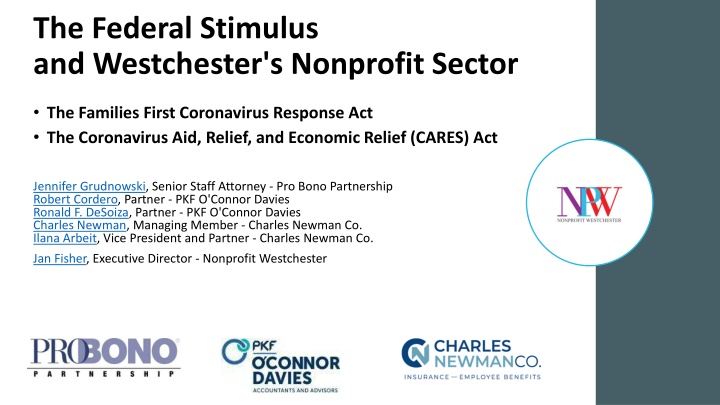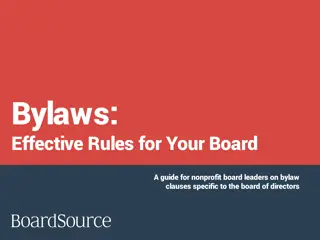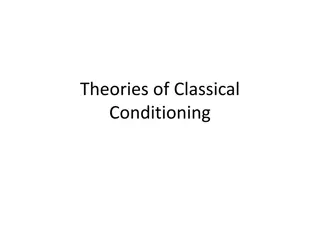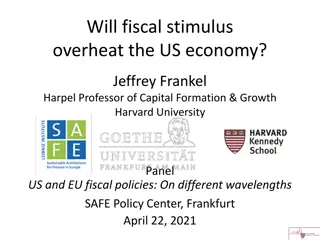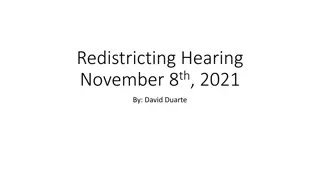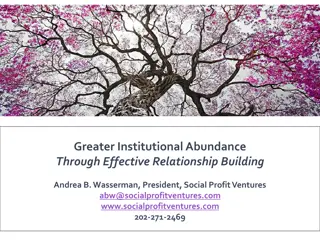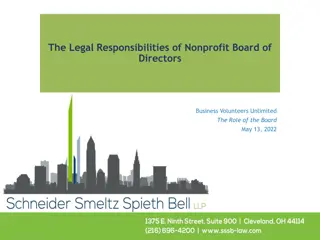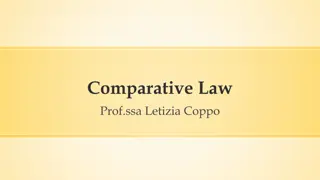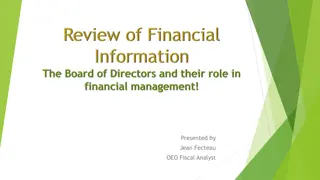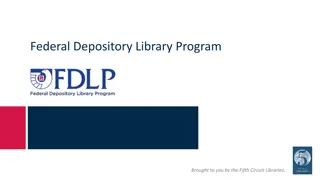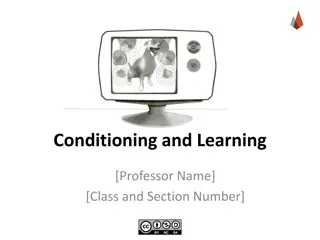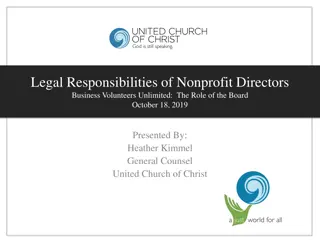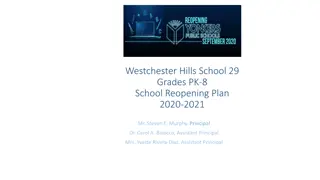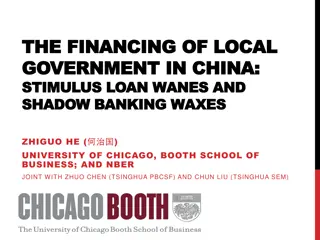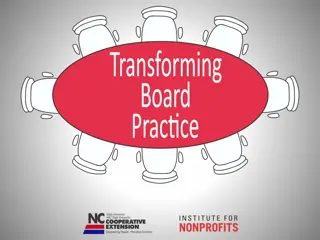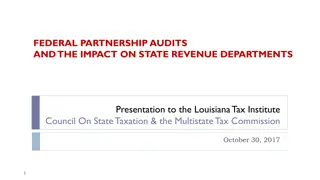The Federal Stimulus Impact on Westchester's Nonprofit Sector
Explore the implications of the Families First Coronavirus Response Act and the CARES Act on Westchester's nonprofit sector. Gain insights from key presenters and sponsors, and learn about employment provisions under these acts. Disclaimer: This presentation does not constitute legal advice.
Download Presentation

Please find below an Image/Link to download the presentation.
The content on the website is provided AS IS for your information and personal use only. It may not be sold, licensed, or shared on other websites without obtaining consent from the author.If you encounter any issues during the download, it is possible that the publisher has removed the file from their server.
You are allowed to download the files provided on this website for personal or commercial use, subject to the condition that they are used lawfully. All files are the property of their respective owners.
The content on the website is provided AS IS for your information and personal use only. It may not be sold, licensed, or shared on other websites without obtaining consent from the author.
E N D
Presentation Transcript
The Federal Stimulus and Westchester's Nonprofit Sector The Families First Coronavirus Response Act The Coronavirus Aid, Relief, and Economic Relief (CARES) Act Jennifer Grudnowski, Senior Staff Attorney - Pro Bono Partnership Robert Cordero, Partner - PKF O'Connor Davies Ronald F. DeSoiza, Partner - PKF O'Connor Davies Charles Newman, Managing Member - Charles Newman Co. Ilana Arbeit, Vice President and Partner - Charles Newman Co. Jan Fisher, Executive Director - Nonprofit Westchester
NONPROFIT WESTCHESTER Our Mission: To strengthen the visibility, capacity and impact of the nonprofit sector in Westchester for a more just and caring community. JOIN US! OUR ADVOACY AND COLLECTIVE EFFORTS HAVE IMPACT WE ARE STROGER TOGETHER www.npwestchester.org
WITH GRATITUDE TO WEBINAR SPONSORS AND PRESENTERS NONPROFIT WESTCHSTER BOARD OF DIRECTORS AND MEMBER ORGANIZATIONS
DISCLAIMERS This presentation is not and should not be construed as legal advice nor does this presentation create an attorney-client relationship between you, your organization, the presenter or the Pro Bono Partnership. The content of this presentation is for informational purposes only. If you have specific questions about the practices of your organization, you should contact an attorney for advice. The material presented in its entirety is our best understanding at the time of the presentation. The materials and presentation are not intended to offer legal or financial advice.
Employment: Families First Coronavirus Response Act Emergency Sick Leave Provisions Expansion to the Family Medical Leave Act Jennifer Grudnowski, Senior Staff Attorney, Pro Bono Partnership
Emergency Paid Sick Leave Basics Provides emergency paid sick leave for COVID-19 related illnesses Went into effect on April 1, 2020 Will expire on December 31, 2020 Applies to employers with 500 or fewer employees
Emergency Paid Sick Leave (EPLS) Applies to all employees, without regard to how long they have been employed. Provides for 80 hours of paid sick time (over 14 calendar days) for full time employees (40+ hours per week) prorated paid sick time based on an average of part time employees hours worked in the six months prior to taking leave for the employer
Emergency Paid Sick Leave (EPLS) For the following reasons: 1. Employee is subject to a federal, state, or local quarantine or isolation order related to COVID-19; 2. Employee has been advised by a health care provider to self- quarantine related to COVID-19; 3. Employee is experiencing symptoms of COVID-19 and seeking medical diagnosis;
Emergency Paid Sick Leave (EPLS) 4. Employee is caring for individual who is subject to an order as described (1) or has been advised as described in (2); 5. Employee is caring for a child if school or place of care has been closed, or child care provider is unavailable, due to COVID-19; 6. Employee is experiencing any other substantially similar condition specified by the Secretary of Health and Human Services in consultation with the Secretary of the Treasury and the Secretary of Labor.
Emergency Paid Sick Leave (EPLS) Employee must be paid 100% of their regular rate of pay or the applicable minimum wage, whichever is greater Employers are only required to pay employees two-thirds of their regular rate of pay if they are using leave for reasons (4), (5), or (6). The amount of payment for EPSL for reasons: (1), (2), or (3) can be capped at $511 per day and $5,110 in the aggregate (4), (5), or (6), can be capped at $200 per day and $2,000 in the aggregate
Emergency Paid Sick Leave (EPLS) Employees cannot be retaliated against for the use this EPSL Employees should be returned to work in the same or substantially similar job they had before they went on EPSL, with some exceptions like a full office closure See DOL Guidance: https://www.dol.gov/agencies/whd/pandemic/ffrca-questions
Emergency Paid Sick Leave (EPLS) The Secretary of Labor is authorized to issue regulations to: Exclude certain health-care providers and emergency responders from receiving this new EPSL benefit; Exempt small businesses with fewer than 50 employees from providing EPSL for the fifth reason set forth above when providing such EPSL would jeopardize the viability of the business.
Emergency Family Medical Leave Act Leave (Emergency FMLA) Basics Provides paid time off for certain caregivers for COVID-19 related closings Went into effect on April 1, 2020 Will expire on December 31, 2020 Applies to employers with 500 or fewer employees
Emergency FMLA The changes to FMLA establish a new category of leave under the FMLA: a leave for a qualifying need related to a public health emergency related to COVID-19, defined as when an employee is unable to work (or telework) due to a need for leave to care for the employee s son or daughter who is under 18 years of age if the child s school or place of care has been closed, or the child care provider of the child is unavailable, due to a public health emergency.
Emergency FMLA Employees only need to have been employed for 30 calendar days before they become eligible for a leave related to a public health emergency This is instead of the usual FMLA requirements (that require an employee to have worked for the employer for at least 1 year, worked for 1250 hours in the year before FMLA leave is taken, and worked at a location where at least 50 employees are employed at the location or within 75 miles of the location)
Emergency FMLA The first 10 days of the leave are unpaid, though an employee may elect to substitute any accrued vacation leave, personal leave, or medical or sick leave for unpaid leave After the initial 10 days of leave, the employer must pay the employee for up to 10 weeks of leave at a rate no less than two-thirds of the employee s regular rate of pay The amount of paid leave can be capped at $200 per day and $10,000 in the aggregate
Emergency FMLA Employees of employers with 25 or more employees are subject to the same job protections regularly provided in the FMLA Generally speaking, an employer will need to return the employee to the same job or a substantially similar job upon return from leave Employers with fewer than 25 employees are excluded from this requirement if the employee s job no longer exists due to an economic down turn caused by a public health emergency Employer would be required to try to return the employee to work if circumstances improved during a defined one-year period
It is possible that employees who use EPSL and/or EFMLA may also be eligible to use: Disability NY Paid Family Leave Regular provisions of FMLA Westchester Paid Sick Leave NY COVID-19 Sick Leave Company policies related to time off
EPSL & EFMLA The DOL has issued a new notice that all employers must post in their workplaces by April 1. If employees are working remotely, then an employer must also either (1) email or direct mail the notice to employees or, if the employer has an online portal for employees, (2) post this notice on the portal. If some employees do not have access to the portal, then the e-mail/direct mail method must be used. You can find the notice at: https://www.dol.gov/sites/dolgov/files/WHD/posters/FFCRA_Poster_ WH1422_Non-Federal.pdf
CARES Act- Pandemic Emergency Unemployment Compensation Increased amount someone on unemployment can receive by $600 per UI payment, until July 31, 2020 Reasons why individual cannot work are COVID-19 related (see list at https://labor.ny.gov/ui/cares-act.shtm) This is in addition to the amount received by the state, which is $504 in New York.
CARES Act- Pandemic Emergency Unemployment Compensation Applies retroactively to January 27, 2020 Applies to employees as well as independent contractors and self- employed No longer a waiting period to received UI benefits in NY Extends UI period by 13 weeks (was 26 weeks) https://labor.ny.gov/ui/cares-act.shtm
The New York State Department of Labor has Published FAQ sheet to provide guidance for Unemployment Insurance Benefits
SBA Coronavirus Aid, Relief, and Economic Security (CARES) Act Economic Injury Disaster Loans (EIDLs) (SBA 7(b) Loans) Emergency Economic Injury Disaster Loans (EIDLs) (SBA 7(b) Loans) Paycheck Protection Program Overview (SBA 7(a) Loans) Loan Programs Ronald F. DeSoiza, Partner, PKF O'Connor Davies
Paycheck Protection Program (PPP) (SBA 7(a) Loans) Overview Employment: Families First Coronavirus Response Act Eligibility is expanded: requirements are relaxed; approval processes are expedited; and forgiveness provisions were added. Emergency Sick Leave Provisions Expansion to the Family Medical Leave Act NY Laws Westchester Paid Sick Leave The Paycheck Protection Program is the section of the CARES Act that temporarily modifies the already existing SBA 7(a) Loan Program in order to meet the current, urgent financial needs of nonprofits and small businesses Jennifer Grudnowski, Senior Staff Attorney, Pro Bono Partnership
Paycheck Protection Program (PPP) YOU MAY APPLY FOR LOANS TODAY, FRIDAY, APRIL 3 Sample application: https://www.sba.gov/documents/sba-form--paycheck-protection-program-ppp-sample-application-form Who is Eligible: Nonprofits with 500 or fewer employees Loan Amount: Lesser of 2.5x average monthly payroll for the prior year $10 million
Paycheck Protection Program (PPP) Loan Use: Payroll, Benefits, Rent/Mortgage, Debt (include salaries, wages, tips; vacation, medical or sick leave health and retirement benefits and state and local wage taxes) Payroll Costs Exclude: Compensation over $100,000 for any individual employee Available: Through June 30
Paycheck Protection Program (PPP) How to Apply for Loans Nonprofits are advised to reach out to their primary banking partner as they will be the agents for administering the Small Business Administration (SBA) 7(A) loans Keep in mind, it could be up to a week before the SBA has finalized all necessary details and protocols that allow banks to move forward Call Jan Fisher at 914-439-0203, for referrals to trusted partners who will help you with the application process
Paycheck Protection Program (PPP) Special Provisions No personal guarantees No collateral No requirement to obtain credit elsewhere Maximum loan maturity is 10 years Interest will not exceed 4 percent per annum Loan repayment will be deferred for 6 to 12 months
Paycheck Protection Program (PPP) Loan Forgiveness The amount eligible for forgiveness is based on a ratio: Avg # FTEs per month for 8 wks after loan date Avg # FTEs per month 2/15/19 to 6/30/19* Forgiveness is reduced by any wage reductions in excess of 25% per employee A temporary reduction in head count made between 2/15/20 and 4/26/20 will not reduce forgiveness if corrected by 6/30/20 The amount forgiven is excluded from taxable income * A borrower can alternatively choose to use the period 1/1/20 to 2/29/20
Economic Injury Disaster Loans (EIDLs) (SBA 7(b) Loans) Overview Economic Disaster Assistance Loans are one of several disaster loan (7(b) Loans) overseen by the SBA. The loan program has been temporarily enhanced by the CARES Act.
Economic Injury Disaster Loans (EIDLs) Who is eligible: Private Nonprofits Loan Amount: Up to $2 million Use: Ordinary and necessary business expenses Interest Payments: 2.75% for nonprofits Available: Through December 31, 2020 Key Provisions: Based on credit score Waives personal guarantee up to $200,000 Forgiveness: Generally, No
Economic Injury Disaster Loans (EIDLs) Waivers Personal guarantees on loans up to $200,000 WAIVED 1-year in business requirement WAIVED Ability to obtain credit elsewhere WAIVED Applicants can be approved based on credit score alone without the need to submit tax returns
Economic Injury Disaster Loans (EIDLs) Businesses Located in a Disaster Area Qualified small business (under SBA size standards) Any size nonprofit organization Small agricultural cooperatives Affiliation rules apply in determining size
Emergency Economic Injury Disaster Loans Private Nonprofits may receive an immediate advance (3-days) of up to $10,000 This advance does not have to be repaid (even if the loan is denied)
Economic Injury Disaster Loans (EIDLs) How to Apply Application portal (new, simplified): www.sba.gov/disaster. Businesses that successfully submitted an application or uploaded documents late last week via the temporary document upload portal do not have to take additional action as their applications have been received for processing. Anyone that was unable to complete an application on the prior application portal AND/OR did not upload their application to the document upload portal, should restart their application via the new portal. Advances of up to $10,000 on Economic Injury Disaster Loans also may be available through a form on the portal. If approved, these funds can be used for payroll and other operating expenses and will be forgiven. This Advance may be available even if your EIDL application was declined or is still pending. If you wish to apply for the Advance on your EIDL, please visit www.SBA.gov/disaster as soon as possible to fill out a new, streamlined application. In order to qualify for the Advance, you need to submit this new application even if you previously submitted an EIDL application. Applying for the Advance will not impact the status or slow your existing application.
Which Program to Use The 7(a) and 7(b) programs do not appear to be mutually exclusive, but how they will be coordinated is unclear. The 7(a) program looks like the better program for eligible entities, as it is essentially a grant, not a loan. Businesses with an immediate need should be able to apply for both and, at the very least, receive the $10,000 EIDL grant very quickly. Mid and Larger Size Nonprofits: The National Council of Nonprofits and Other Groups are advocating for loan programs. Information from NPW will be forthcoming
Tax 990 Filings Economic Stabilization Payroll Tax Deferral Employee Retention Credit Implications Robert Cordero, Partner, PKF O'Connor Davies
990 Filings Internal Revenue Service Has Delayed Income Tax Filings NONPROFIT 990 FILINGS NOT DELAYED
Payroll Tax Deferral Description Defer payment of employer payroll taxes and self-employment taxes incurred between March 27, 2020 and December 31, 2020 Eligibility All employers and self-employed individuals (including partners in partnerships) Ineligibility A taxpayer who obtains a PPP loan forgiveness can not use this deferral Amounts The deferral relates to the employers 6.2% social security tax or the equivalent amount for a self- employed individual. No Maximum Deferral date Amounts will be considered timely paid if 50% paid of the deferred amount paid by December 31, 2021 and the remainder by December 31, 2022.
Employee Retention Credit Employee retention credit for wages paid from March 13, 2020 to December 31, 2020 that are subject to closure or significant economic downturn due to Covid-19 Description Operations were fully or partially suspended on orders from a governmental authority due to COVID-19 (COVID-19 Shutdown), or The business experienced a 50% reduction in gross receipts for a calendar quarter as compared to the same calendar quarter in the prior year (Gross Receipts Decline). The eligibility period ends when the business gross receipts for a calendar quarter are 80% of the gross receipts in the same calendar quarter in the prior year. This test requires employers to analyze gross receipts among all aggregated entities` Eligibility Ineligibility Any employer that receives an SBA Paycheck Protection Program loan is not eligible for the Credit Amount The credit amount takes into account up to 50% of qualified wages, which are capped at $10,000. Thus, the maximum credit is $5,000 per employee. Qualified wages include qualified health plan expenses paid or incurred by the employer for health coverage excludable under IRC Section 106(a). Entities with more than 100 employees For employers with an average of more than 100 employees in 2019, qualified wages are wages paid to an employee who is not providing services due to a COVID-19 Shutdown or Gross Receipts Decline. Entities with 100 or less employees For employers of 100 or fewer employees, qualified wages are wages paid to any employee without regard to whether the employee is providing services. Refunds The credit is refundable. However, it is subject to a number of rules to prevent double-dipping. For example, an employer s deduction for wages must be reduced by the amount of the credit. Payroll Tax Deferral An entity that utilizes the credit can still utilize the payroll tax deferral program.
Employee Retention Credit (continued) Reporting Employers can reduce their required deposits of payroll taxes. Eligible employers will report their qualified wages and health insurance costs on their quarterly employment tax returns. Applying for Refund or Advance If employer s employment tax deposits are not sufficient to cover the credit or if employer wants advance of the credit, the employer may receive a refund or an advance payment from the IRS by submitting Form 7200, Advance payment of Employer Credits Due to Covid-19.
What Should I Know About My Health Insurance Plan? What to Ask Your Carriers What Your Carriers Are Doing Ilana Arbeit, Vice President, Charles Newman Co. Charles Newman, Managing Member, Charles Newman Co.
Normal eligibility requirements are being relaxed Carriers are relaxing eligibility requirements in some of the following ways Allowing furloughed employees to remain on the plan Allowing employees who are not working enough hours to remain on the plan Allowing employers who may not currently meet participation requirements to remain on the plan
Special Enrollment Periods Employees who previously waived group health coverage may be able to join now Open enrollment ending TODAY or MONDAY Some state exchanges are open for individuals who have been laid off
COVID-19 Related Expenses All carriers covering in-network testing at no charge Carriers are offering access to telehealth services at no charge Carriers offer a 24/7 nurse line Some carriers covering in-network treatment at no charge
Prescriptions Carriers are waiving early refill limits on maintenance medications Check your carrier s policy regarding mail order prescriptions
Premium Grace Periods Some will consider on a case-by-case basis Life insurance premium grace periods are extended
Short Term Disability Standard STD Policy: Self quarantining would not meet the criteria to collect benefits COVID-19 is an illness and will be evaluated as any other illness as addressed in your contract
